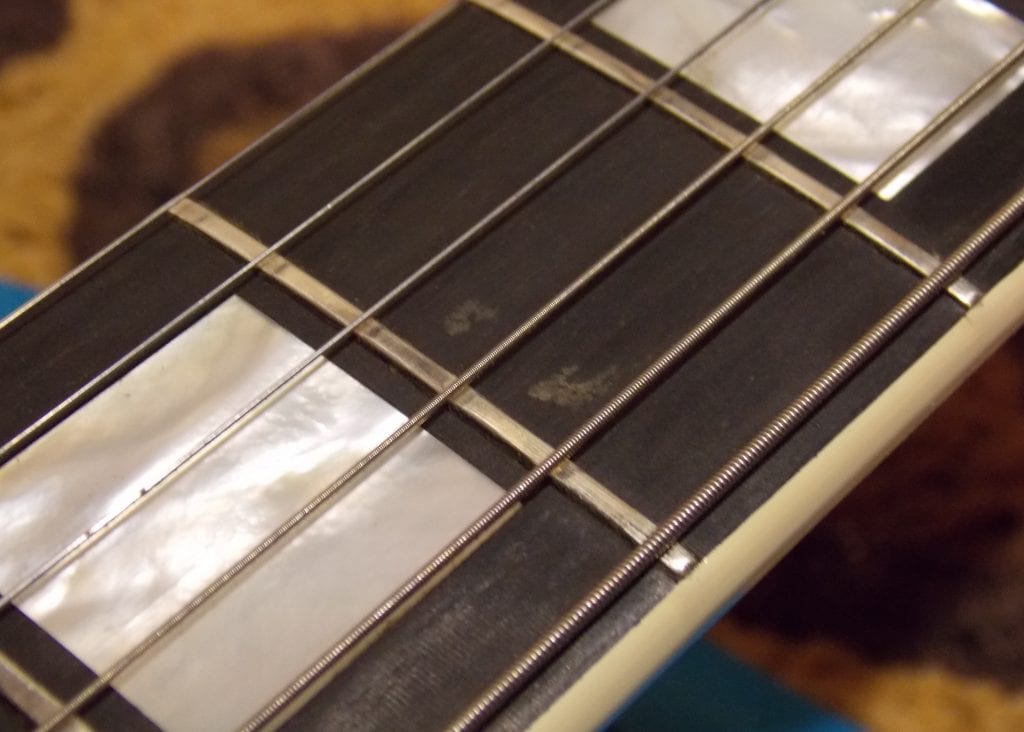Should I Get My Guitar Restrung?
Often times customers walk in to the store distraught that a string on their guitar broke. When I pull the suspect out of the gig bag I’m never surprised but always horrified to find that the strings haven’t been changed once since the guitar was purchased. My customers will often ask how often to change strings, some are surprised to learn that they need to be changed at all. If you didn’t know either, it’s perfectly normal, just like anything else guitar maintenance has to be learned over time. I wanted to take a moment today to give everyone seven signs that anyone can watch for. If you answered yes to any or all of these questions, it’s about time to get your guitar restrung.
1. Is there gunk under the strings?
Take your finger, place it between the fretboard and string, now with the soft part of your finger touching the string run your finger up and down the fretboard. does the string feel rough or coarse? The roughness you are feeling is an accumulation of rust on the string as well as dead skin cells and oils that many guitar players have come affectionately refer to as “Finger Fudge”
2. Is the fretboard clean or dirty?
Remember that “Finger Fudge” I told you about? those dead skin cells and oils will build up on the fretboard over time leading to a grayish clay looking substance that builds on the fretboard. If you just changed strings and forgot to clean the fretboard go buy a pack of strings for next time and make a note to yourself on the pack so you remember to clean the fretboard. Many companies make a lemon oil or other fretboard cleaning solution that takes finger fudge right off, but hey, why not get the guitar restrung and let the pros do it for you?
3. Do the strings look splotchy or discolored?
Depending on what type of strings you have you will want to look for different colors, but one easy way to tell is by looking at places where the strings don’t get touched often. The headstock by where the strings wrap around the tuning posts as well as on the back side of the saddle are great examples. These places will show you what the string’s natural color is. If you look anywhere else and it seems darker it may be time for a change. Some strings, however, age and darken everywhere, so here is a quick guide to string colors. Acoustic strings are normally a brilliant gold color (80/20 bronze) or a honey wheat color (phosphor bronze) depending on the metals used. if the string is closer to a mocha or darker shade of brown and doesn’t look quite as shiny anymore, it’s time to get that guitar restrung Electric strings will appear silver and shiny, and will sometimes have a slight blue-ish purple tint to them (cobalt) if they loose their shine and take on more of a grey color it’s time to get your guitar restrung
4. How do the strings sound?
Remember when you first put those new strings on and your guitar sounded so much brighter and alive? As a string ages, so does your tone. if your tone sounds plunky or dead, and has lost that bright pop or warm resonance that you like it may be time to get that guitar restrung.
5. Were the strings wound properly around the post?
I can’t tell you how many times I’ve seen a freshly strung guitar come in with the customer complaining that the strings won’t stay in tune. To my dismay I have to show them that the guitar was not strung properly, and without enough wraps around the post the string will continue to slip until it eventually comes loose. to avoid this make sure you have 2-3 wraps around the post on the bass side, and 3-4 wraps on the treble side, or just take it to your local shop and let the pros do it.
6. Is the guitar holding tune?
With tuning issues strings are not always the culprit, but if I’ve exhausted every other possibility, I’ll change strings, and that just might do the trick. It’s at least worth a try, and worst-case scenario you spend a few bucks and get a brand new sounding guitar. Sometimes a bad set of strings can also be the reason for intonation issues, and strange vibration patterns, but I’ll normally check every other possibility before changing strings.
7. Has it been more than a few months?
If nothing else strings will normally loose their tone after a few months. An uncoated set of strings will last anywhere between 2 and 4 months before really loosing their tone, however many musicians will change once a month, or every other month. Coated strings are, however, a completely different story. Companies like Elixir, Cleartone make coated strings for electric or acoustic guitars. Coated (or treated) strings will usually last between 4 and 6 months.
Questions or Comments?
Get more info on getting your guitar restrung by
Calling us at: 801-298-4777
Emailing: mail@murphysguitars.com
or visiting us on social media
Click To Shop Strings



